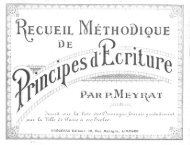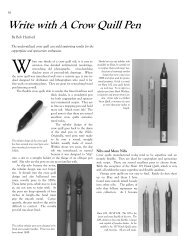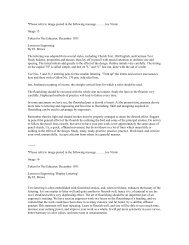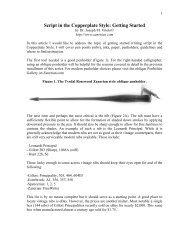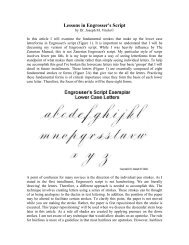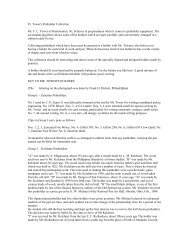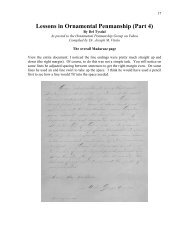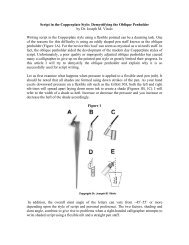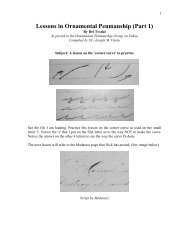The Educator (Volume 45) - IAMPETH
The Educator (Volume 45) - IAMPETH
The Educator (Volume 45) - IAMPETH
You also want an ePaper? Increase the reach of your titles
YUMPU automatically turns print PDFs into web optimized ePapers that Google loves.
18<br />
—<br />
Handwriting Lesson<br />
By JAMES T. MAHER,<br />
Marion Business College, Marion, Ind.<br />
This shows how Mr. Maher carefully and systematically develops the lesson at the blackboard where<br />
pupils can see the movement.<br />
Check or rule your paper to provide<br />
two-inch spaces. Sit tall, squarely<br />
in front of the desk, both feet on<br />
the floor, the left a little in advance<br />
of the right; both arms on the desk,<br />
the elbows projecting over the edge;<br />
curl the fingers back under the hand<br />
to elevate the wrist and heel of the<br />
hand from the paper; hold the pen<br />
loosely between the thumb and second<br />
finger, letting the tip of the index<br />
finger rest lightly on the holder.<br />
Keep in mind the three points of<br />
contact—the muscle in front of the<br />
elbow, the last two fingers, and the<br />
pen point. Relax all the muscles of<br />
the body. Test your movement by<br />
seeing that the fingers slide with the<br />
pen.<br />
Now take up the ovals. Begin<br />
with a small loop and continue with<br />
the retraced oval one space in height,<br />
down on the right, up on the left<br />
lines light and the<br />
Put five ovals in a<br />
fingers sliding.<br />
section. Move<br />
the paper at the end of each section,<br />
using the left hand. Continue with<br />
the straight lines, push and pull, fingers<br />
sliding. Are the lines extending<br />
toward the center of the body?<br />
If not, note the position of your<br />
paper. <strong>The</strong> amount of time spent on<br />
<strong>The</strong> accompanying lesson was<br />
received from Mr. James T.<br />
Maher. It represents one of<br />
his daily lessons. <strong>The</strong> <strong>Educator</strong><br />
earnestly solicits other teachers<br />
in business co 1 1 e g e s, high<br />
school and grade schools to<br />
submit one of their entire lessons<br />
so that other teachers<br />
may see what they are doing.<br />
<strong>The</strong>se lessons do not have to<br />
be out of the ordinary, but<br />
simply average lessons in which<br />
the average teacher is interested.<br />
warming-up exercises will depend<br />
upon how well you have the funda-<br />
mentals of position and movement<br />
—<br />
they are first conscious eiforts, but<br />
later become automatic. Don't be<br />
too critical of form at first, as it<br />
takes time to bring the large muscles<br />
of the upper arm and shoulder into<br />
use and under control.<br />
Study the form of the large "W"<br />
at the right and left. Note the comparative<br />
height of the parts. <strong>The</strong><br />
center of the letter is the tallest;<br />
the finishing stroke is the shortest.<br />
Note the space between the first and<br />
second down strokes of the stem.<br />
Note also that all strokes are slightly<br />
curved, with little retracing. A<br />
slight check in the motion is necessary<br />
at the base, and at the top.<br />
Think a rhythmic count of 1, 2, 3, 4;<br />
or, over, under, down, over. Move<br />
the paper with the left hand as you<br />
write across the line. Get sixteen<br />
letters on a line, keeping them not<br />
taller than % the distance between<br />
the lines. After writing a line, check<br />
the points mentioned above. Draw a<br />
ring around the good letters. Write<br />
several lines.<br />
In writing the words and sentence<br />
watch beginning strokes, spacing<br />
slant, turns, and endings. Let the<br />
swing of the arm carry the hand forward,<br />
but use the thumb and fingers<br />
slightly on the down strokes and<br />
tui-ns. Write as rapidly as you can<br />
write well. As supplementary work,<br />
write the small letters in groups, on<br />
the line, and across the lines.<br />
Don't be discouraged. Keep working.<br />
You won't see all the points<br />
about letters and movement at the<br />
start. It takes time, but it is worth<br />
the efl'ort. Send in a page of your<br />
best work. Good luck.<br />
Mr. Maher passes among the students correcting position and giving individual criticisms and copies like the above.



